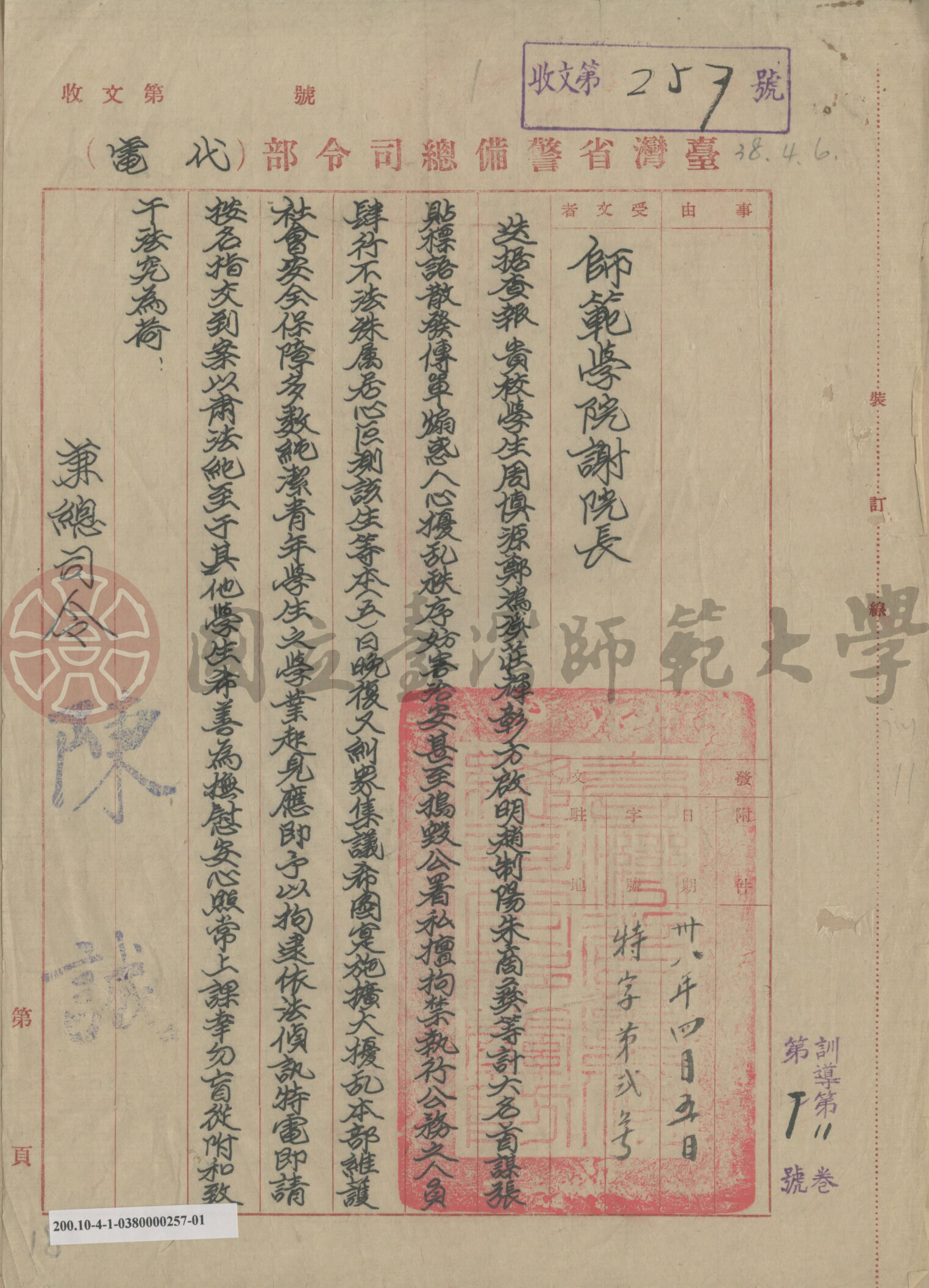To equip students with a patriotic mindset, an energetic spirit, and a strong physique, Taiwan Provincial Teachers College held flag-raising ceremonies and morning exercise sessions beginning in 1949. All members of the Office of Student Affairs, military training instructors, and all students were required to rise at 6 every day and assemble on the sports field in uniform for roll call. The president would then lead the flag-raising ceremony and morning exercise session. Unauthorized absences were punished. In 1954, the Regulations for the Management of Flag-Raising and Lowering, Morning Exercise, Evening Roll Call, and On- and Off-Campus Assemblies were issued, requiring all students to participate in flag-raising ceremonies and receive military training. The flag-raising system was terminated in 1997 during the tenure of President Lu Xi-Mu.
It was such a chore to attend the flag-raising ceremony and listen to lectures every day. It seemed that NTNU was the only university with such a rule. I was often absent because I couldn’t get up in the morning. A teacher in the Office of Student Affairs told me that I had missed the roll call many times and that I would get a demerit if I didn’t start showing up on time. President Liu Chen was an excellent speaker, and he gave a different speech each day. Unfortunately, I was mostly groggy, didn’t eat breakfast, and nearly fainted several times.──Chin Ching-Yun (Class of 1954, Department of Music, alum and retired professor). “Those Years at NTNU,” I, Too, Can Sing Softly, p. 191. October 2024.
I will never forget the flag-raising ceremony and morning exercises. A little after six each morning, the military instructor would blow the whistle twice to wake us up. We “had no choice” but to reluctantly get out of bed, freshen up, get dressed, and line up on the sports field to watch the “Blue Sky, White Sun, and a Wholly Red Earth” flag rise slowly in the morning light to the blaring music. Then, “one, two, three, four; two, two, three, four...” I followed everyone in doing morning exercises. I was always extremely reluctant before getting up, but the morning exercises energized me.——Hu Te-Hai (Class of 1968, Department of Adult and Continuing Education). “Unforgettable Alma Mater,” NTNU Alumni Monthly: 30th Anniversary Special Issue, p. 8. June 5, 1976.
As a core academic principle, Taiwan Provincial Teachers College aimed to strengthen national identity and valued Chinese language teaching. Compulsory Chinese courses for freshmen became a distinguishing feature of the school. After it was restructured into a university in 1955, it continued to implement non-credit standard Chinese pronunciation courses. In terms of both the number of credits and course content, the compulsory courses of each department at Taiwan Provincial Teachers College were far more rigorous and detailed than what was required by the Ministry of Education. This shows that, in addition to training secondary teachers with professional knowledge, it also cultivated talent in academic research.
School officially started in early September. Since it hadn’t been long since Taiwan was liberated (from the Japanese), most of the local students did not speak Chinese, so students and professors used a mix of Japanese, Hokkien, Chinese, local dialects, and English to just barely communicate.——Hung Kuei-Chi (Class of 1950, Department of Chinese). “Cheering for the Development of Our Alma Mater,” NTNU Alumni Monthly: 31st Anniversary Special Issue, p. 15. June 5, 1977.
Semester exams at our alma mater always took place in the gymnasium and the two exercise rooms on either side. Each year’s second-semester exams always took place during the hottest time of the year, around the end of June or early July. There were no windows at the front of the gym, while the back was exposed to sunlight. Being steamed on one side and roasted on the other practically turned the exams into “grill sessions.” We were sweating buckets and dizzy with heat. By the time we finished one exam, even the outer layers of our clothes were drenched in sweat.——Sun Yan-Min (Class of 1958, Department of History and Geography). “My Memories of Alma Mater,” NTNU Alumni Monthly, Issue 49, p. 3. June 5, 1967.
In the early days, students who lived in the Taiwan Provincial Teachers College dormitories had a student-organized catering service that was responsible for preparing three meals a day. Students who joined paid a monthly fee and received vouchers called meal tickets or food tickets. Due to limited public funds, the service often offered the simple “two entrees and one soup,” but many former students are still nostalgic for the old flavors.
Former students recall that the cafeteria was usually already bustling before mealtime officially began. Long lines formed in the hallway—some students showed up with plastic tubs; others with large bowls. The early birds not only got to enjoy the food while it was still warm; they also got the oil on the top surface of the soup and the few slices of meat. This led to the humorous saying among students: “The early eater gets the oil.” Due to the scarcity of resources in the early days, male students were provided with two entrees and a soup. The most common entrees were braised winter melon, boiled peanuts, miso soup, and stir-fried cabbage. As female students generally ate less, they were provided with one meat and one vegetable entree. The early catering service also provided an additional “à la carte” service, which sold items such as eggs braised with soy sauce, braised meat, and braised tofu, giving students an opportunity to treat themselves after class. The catering service was discontinued around 1974.
The catering service served meager dishes like cabbage and miso soup for every meal. Even baked sesame flatbread and deep-fried dough sticks would be a tremendous addition. We bought peanuts for 20 cents as midday or midnight snacks. You couldn’t eat them yourself either—you had to share. Each person got three or four peanuts, and it was the most delicious treat. Although life was hard, everyone was healthy and full of energy. I still talk about it with great relish and have endless recollections of those days.——He Wen-Chin (Class of 1952, Department of Chinese). “Remembering Alma Mater,” NTNU Alumni Monthly, Issue 197, p. 20. June 5, 1981.
Back then, we had a monthly food allowance of 47 dollars. We would spend 23 on groceries, leaving 24 for miscellaneous expenses. During a catering service meeting, some students advocated spending 35 dollars on food and keeping 12 for haircuts. However, students without any source of income disagreed, insisting that the 24 dollars for miscellaneous expenses must be preserved and that it didn’t matter if we had to eat a little worse. I remember Chang Hung and Hung Yi-Chuang getting into a fight over this matter, each grabbing a plier that happened to be lying around in Room 216 and hitting the other with it, hitting each other in the head until they were bleeding all over the floor. Fortunately, someone from the Office of Student Affairs intervened, but chose not to punish them. They asked them to shake hands and make peace, which ended the dispute.——Hsieh Yun-Fei (Class of 1954, Department of Chinese, Class of 1959, Graduate Institute of Chinese). “Looking Back Over the Past Thirty Years,” NTNU Alumni Monthly, Issue 221, p. 22. June 5, 1985.
The original cafeteria was on the men’s side of the dormitory. The women had to line up there with their bowls and chopsticks while the men would lean against the dormitory windows, jeering and catcalling, which was extremely annoying. I suggested separating from the men and moving back to the women’ cafeteria. Because women ate a lot less rice than men, we could use the money saved to buy extra food. So I was elected chair of the Meal Committee. You could say I was an unwitting feminist trailblazer.──Chin Ching-Yun (Class of 1954, Department of Music, alum and retired professor). “Those Years at NTNU,” I, Too, Can Sing Softly, p. 191. October 2024.
In the early days of Taiwan Provincial Teachers College, the Shichisei Dormitory of Taihoku Higher School was repurposed into the female dormitory. In 1950, a two-story male dormitory with north and south wings was constructed on Longquan Street. In 1959, a three-story dormitory for female students and faculty and staff families was built in front of the original Shichisei Dormitory. It was used until 1982, when it was demolished along with the Shichisei Dormitory ahead of the construction of the Liberal Arts Building I.
In the summer of 1972, renovations began on the student dormitory originally located on Longquan Street, as it was old and had limited capacity. Despite facing challenges brought on by the oil crisis during the construction period, the project overcame all difficulties and was completed in 1974. The building was designed in an H-shaped layout, with separate dormitory wings for male and female students. The building was five stories high, with 55 rooms on each floor, accommodating over 3,000 students. The building’s facilities were considered advanced at the time; they were well received by students, and became the envy of students from other universities.
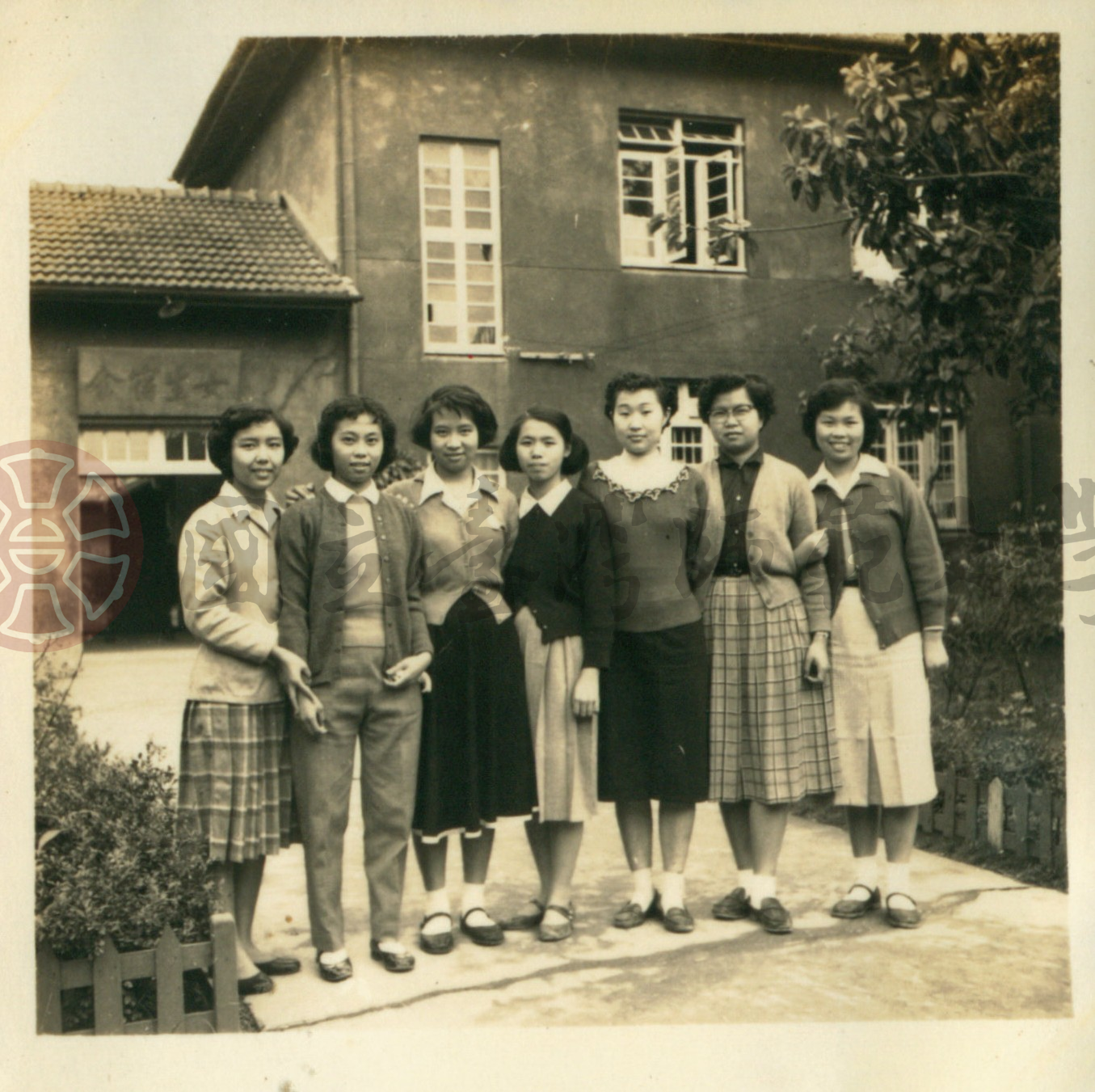
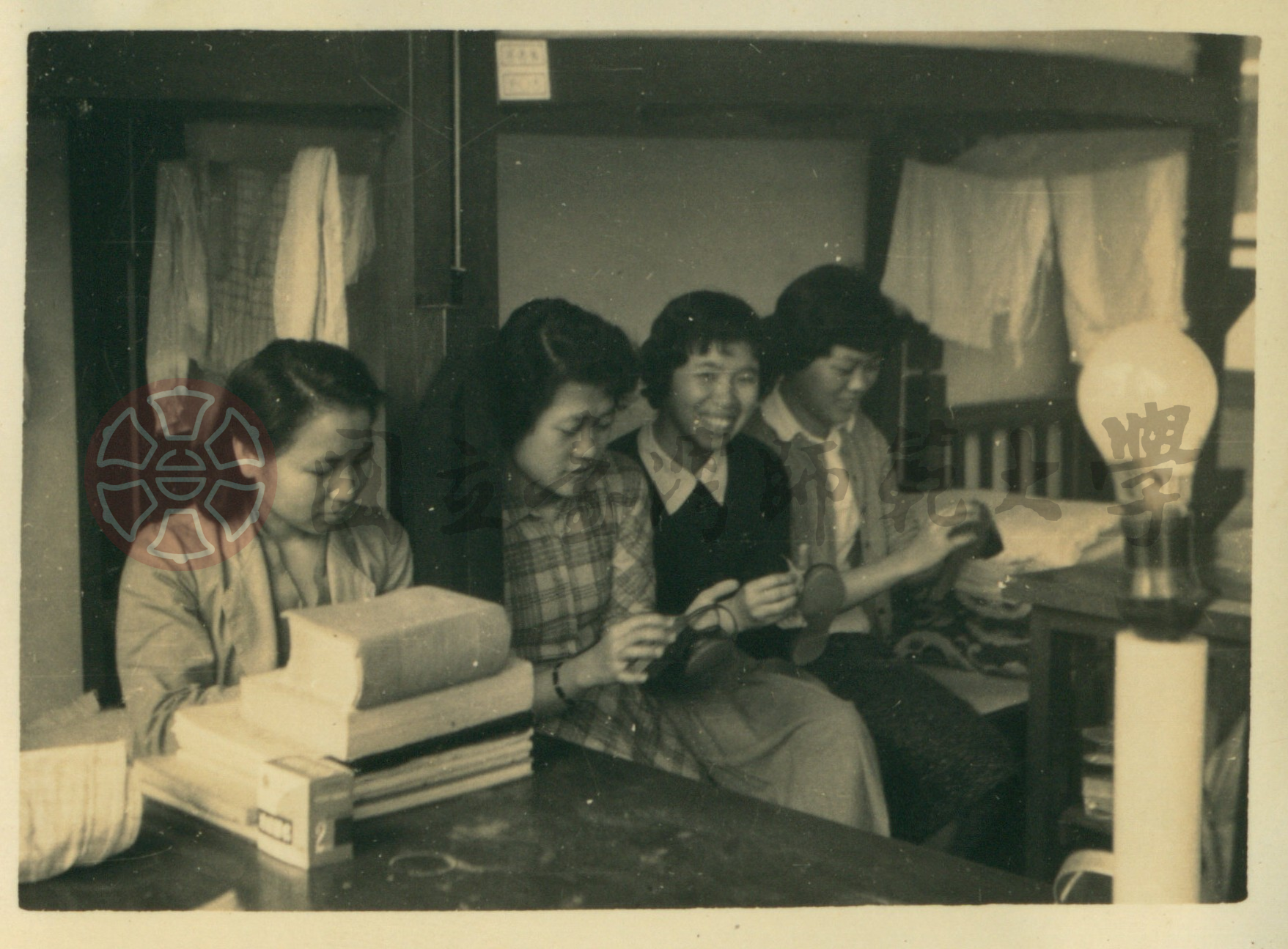
In the early days of Taiwan Provincial Teachers College, arts and cultural clubs flourished. The Peking Opera Study Society, founded in 1949, performed every semester, and its signature play, “Famen Temple”, was widely acclaimed. Drama clubs included the Taiwanese Opera Club, founded in 1947. The club performed in the local language and attracted over 300 students to join (there were about 600 students in the whole school at the time). There was also the Friends of Opera Club centered around the Department of Art and the People’s Opera Club supported by Chair Yu Shu-Lin of the Department of Education, who believed in the educational function of drama. The club’s performance of “Gold and Jade Fill the Hall” at Zhongshan Hall was a sold-out sensation. These two drama clubs of a similar nature merged into the Taiwan Provincial Teachers College Opera Club in 1950. From scripts and makeup to lighting effects, everything was done by the members, demonstrating a high degree of autonomy and collaboration.
As for academic clubs, The Humanities Club, founded in 1950, focused on history, culture, and social studies. It regularly held lectures and published The Humanities Bulletin, hoping to provide a stabilizing force in a time of upheaval. The famed philosopher Mou Tsung-San was invited to hold philosophy lectures. The Stream Poetry Club, formed by students from the Chinese Department and the Chinese language specialized training course, showcased literary creativity through the publication of poetry journals and the organization of modern poetry forums. Among its members was Lin Liang, who later became a well-known author of children’s literature. The publication Teachers College Youth, founded in 1954, reported on new school policies and campus news, and served as a bridge of communication between the school administration and students. Its editorial team, the Taiwan Provincial Teachers College Youth Editorial Committee, was restructured into the NTNU Youth Society after Taiwan Provincial Teachers College was upgraded to a university in 1955, and the publication was renamed NTNU Youth.
In addition, the Overseas Chinese Students’ Association, established in 1952, was a social organization that made significant contributions to strengthening camaraderie among overseas Chinese students. As for recreational clubs, there was the Wind Instrument Band established in 1950, which provided accompaniment for major on-campus ceremonies, and the Chinese Music Club, established in 1953.
During my tenure as president of the Taiwan Provincial Teachers College Opera Club, we performed “Adversity Reveals True Character”, “Careful with Fire”, “Between Man and Beast”, “Proposal”, “Ideal Wife”, and “Group Meeting”. Back then, the Taiwan Provincial Teachers College Opera Club had not only established a good reputation among students on campus, but also attracted students who loved drama from other colleges and senior high schools in Taipei City, who came to watch our performances. This achievement was mainly thanks to the skilled acting and directing of Lee Tz-Da (who later became the well-known director Lee Hsing), Feng Yu-Chu, Pai Ching-Jui, and Liu Fang-Kang. Their success led to many high school drama performances inviting them to serve as directors. Today, aside from Feng Yu-Chu, who studied abroad in the U.S. and became an audio-visual education expert, Lee Tz-Da, Pai Ching-Jui, and Liu Fang-Kang all went on to become some of the most well-known directors in Taiwan.——Yen Ping-Yu (Class of 1953, Department of Education), “Unforgettable Campus Life and Activities in the Early Days of My Alma Mater,” National Taiwan Normal University 50th Anniversary Special Issue, p. 75. June 5, 1996.
At that time, Taiwan Provincial Teachers College had two long-running and very renowned lecture series, both organized by The Humanities Club. One was a lecture series on stories from Chinese history by Professor Chen Chih-Ping (Chiung Yao’s father), which was held every Friday night from 7 to 9 p.m. in the Assembly Hall, rain or shine. After dinner, you would see many people queuing at the door, waiting to get in. The venue was truly packed. It was an unprecedented success that ran for five to six years. The other lecture series was Professor Pan Chung-Kuei’s Four Books Lectures, which started at 8:30 a.m. every Sunday. I remember it clearly to this day. Every time, it was the senior student Wang Mei-Huan from the Department of Education who would walk into the Assembly Hall with a hand-cranked bell in hand, prepare the chalk and teacup for the professor, then ring the bell on the dot. Students would file in and take their seats in an orderly fashion. When Professor Pan arrived, everyone would stand up without prompting and say “Good morning” to the professor in unison! Then, everyone would sit down and listen to the lecture attentively. I think he started with the teachings of Mencius. There were two to three hundred people listening to the lecture each time. After the lecture, the entire audience would stand, bow, and applaud in a gesture of respect. Professor Pan would calmly step down from the podium, return the gesture with a gentle smile, and slowly walk down the central aisle out of the Assembly Hall. Only then would the audience slowly begin to disperse. That solemn and harmonious atmosphere marked by a reverence for teachers and the dignity of scholarship still moves me deeply whenever I recall it.——Li Kan, (Class of 1955, Department of History and Geography), “Recalling the Past as an Old Boy,” National Taiwan Normal University 50th Anniversary Special Issue, p. 143. June 5, 1996.
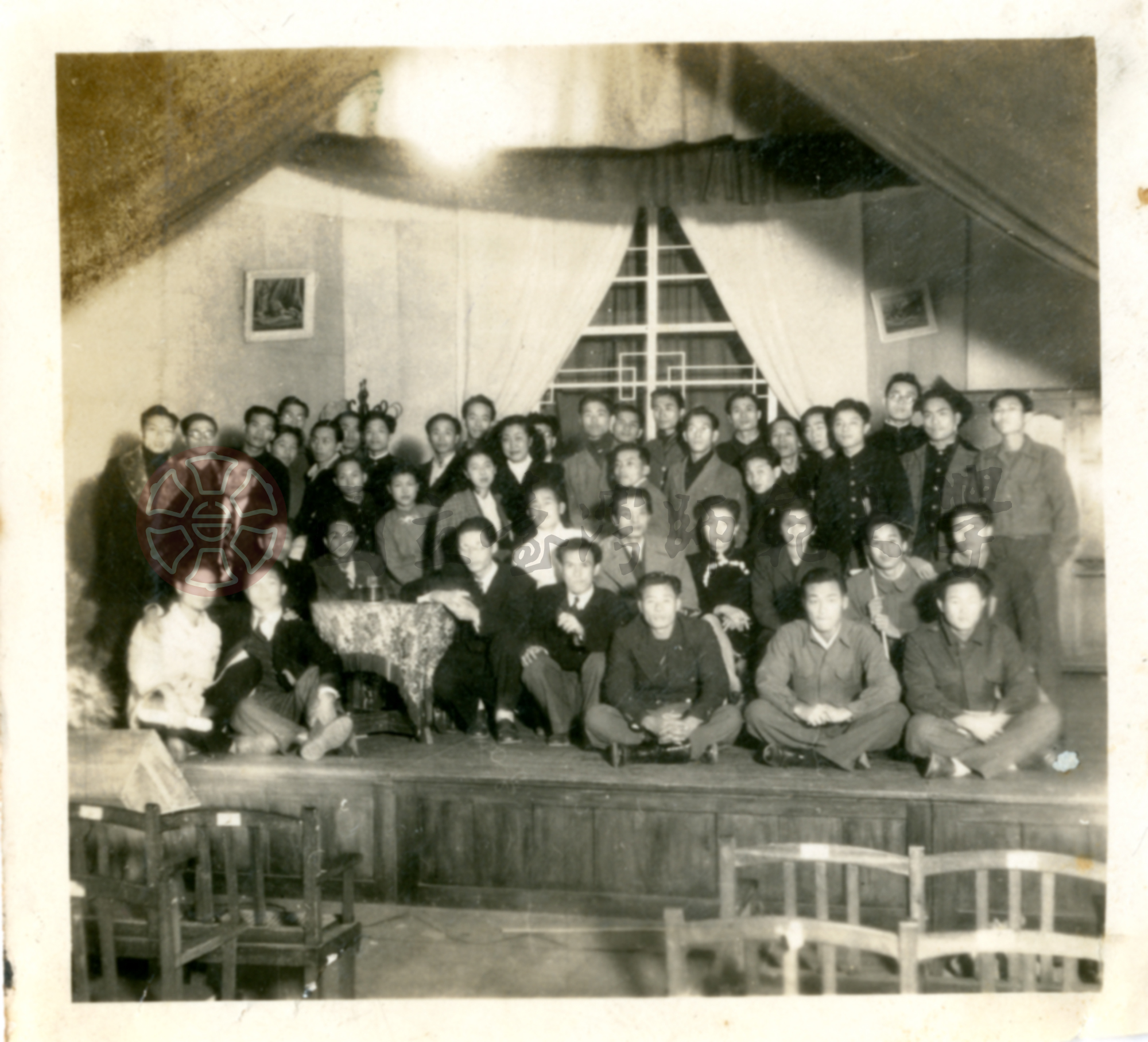
Taiwan Provincial Teachers College was granted official status on June 1, 1946 and opened on June 5. On September 28 of the same year, the founding ceremony was held in the Assembly Hall. In March 1951, the 21st Administrative Council of the Taiwan Provincial Teachers College resolved to designate June 5 of each year as the school anniversary, and reported the matter to the Education Department for approval. The first school anniversary celebration was held on June 5 of the same year. The activities included commemorative ceremonies, sports meets, concerts, and receptions. Since then, a variety of traditional and innovative celebratory activities have been held every year on the school’s anniversary, making it one of the university’s key annual ceremonies.
After the war, students of Taiwan Provincial Teachers College were required to wear uniforms. In 1956, the Ministry of Education required university and college students to wear uniforms, a rule that was gradually abolished in the 1990s. Nowadays, the only uniform which students are required to wear is a shirt embroidered with the emblem and name of the school, worn during their internship as part of teacher training.
The uniform was light grey in color and had a nice design that made one look lively and energetic when wearing it. However, the fabric was thin and of very poor quality, truly a rough cloth garment. We viewed this uniform the way a doctor at the hospital might view their thin white smock. We only wore it during flag-raising ceremonies and school external activities, and rarely touched it on weekdays.──Lin Liang (Class of 1952, Chinese language specialized training course). “The Sound of the Bell – Ten Questions on the Past,” NTNU Alumni Monthly, Issue 197, p. 12. June 5, 1981.
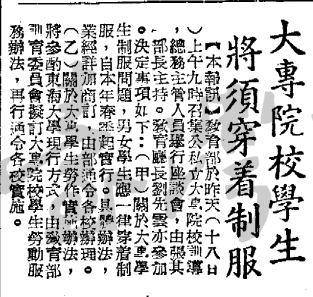
When Taiwan Provincial Teachers College was first established, the school adopted a relatively liberal approach to student management. After the February 28 Incident, the government required all schools to adopt stricter disciplinary measures. Although Taiwan Provincial Teachers College increased student advisors’ supervision of students, the academic atmosphere remained relatively free and diverse. However, as tensions between the Kuomintang and the Communist Party escalated, the disciplinary policy became progressively stricter.
The April 6 Incident, which occurred from March to April of 1949, became the catalyst for a major shift toward discipline and military training. The incident started on the evening of March 20, when National Taiwan University student Ho Ching-Yueh and Taiwan Provincial Teachers College student Li Yuan-Hsun violated traffic regulations by riding together on one bike, for which they were beaten and detained by the police. Students from the two schools then surrounded the police station in protest and took to the streets the next day to express their anger. They also organized a provincial student federation in an attempt to force the government to respond to their demands. Chairman Chen Cheng of the Taiwan Provincial Government ordered the military to thoroughly investigate the ringleaders. On April 5, official directives were sent to the two schools requesting their cooperation in arresting those who “posted slogans, distributed leaflets, incited people, disrupted public order, endangered public security, and even destroyed government offices and detained personnel performing official duties without authorization.” In the early morning of April 6, the Taiwan Garrison Command dispatched military and police forces to surround the male dormitory of Taiwan Provincial Teachers College and two student dormitories of National Taiwan University located on Xinsheng South Road and Qingdao West Road, arresting approximately 300 students of Taiwan Provincial Teachers College and 30 to 40 students of National Taiwan University. This incident marked the first time since the end of World War II that military and police forces entered a campus to arrest students, signaling the beginning of the White Terror era on campuses.
After the April 6 Incident, Dean Hsieh Tung-Min of Taiwan Provincial Teachers College resigned resolutely and was succeeded by Legislator Liu Chen. From April 6 on, Taiwan Provincial Teachers College temporarily suspended classes for reorganization in compliance with orders of the provincial government and required students to re-register for their studies. On the 8th, the provincial government established the Committee for Rectifying Academic Conduct, formulating the Regulations for the Selection of Students and Regulations for Student Re-Registration to re-assess students’ eligibility. Classes resumed on the 29th. Although most of the students arrested in the incident were eventually released, 36 students were expelled. Afterwards, the government declared martial law, and the Security Command further strengthened ideological surveillance of teachers and students at Taiwan Provincial Teachers College. The new dean, Liu Chen, formulated the Regulations for the Management of Student Flag-Raising and Lowering, Morning Exercises, and On- and Off-Campus Assemblies, which required students to attend daily morning assemblies and flag-raising ceremonies. Dormitories were also constructed, forcing students to live together in groups. The school also fully implemented the student advisor system to oversee students’ character, academic performance, and everyday behavior. The concept of civil disturbance in the Criminal Code was also incorporated into school regulations, clearly stipulating that “students who endanger the country and attempt to overthrow the government, and who are sentenced by public security agencies, will be expelled from school.” From then on, student life became more restrictive, while the campus atmosphere became increasingly solemn and conservative as the school entered a stage of strict military-style management.
Since its establishment, Taiwan Provincial Teachers College had implemented military training as part of its curriculum. Beginning in 1954, this training was carried out by the China Youth Anti-Communist National Salvation Corps, in accordance with the Regulations on Military Training and Management for Post-Secondary Institutions. In 1959, planning and management of such training was transferred to the Ministry of Education, with active-duty military personnel appointed as instructors responsible for students’ military training and daily conduct. With the arrival of social democratization in Taiwan, in November 2015, the National Taiwan Normal University Council decided to amend its Organizational Charter, merging the Military Training Office and the Dedicated Counselors’ Office under the Office of Student Affairs and officially renaming it the Student Adviser Office, becoming the first university in Taiwan to abolish its Military Training Office.
